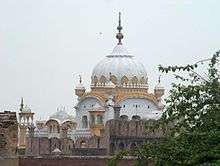Samadhi (shrine)

Samādhi (Hindi: समाधि) or samadhi mandir is the Hindi name for a temple commemorating the dead (similar to a tomb or mausoleum),[1][2][3] which may or may not contain the body of the deceased. Samadhi sites are often built in this way to honor people regarded as saints or gurus in Hindu religious traditions, wherein such souls are said to have passed into mahāsamādhi, or were already in samādhi (non-dualistic state of consciousness) at the time of death.
The tradition of India is cremation for most Hindu people at the time of death, while samadhi is generally reserved for very advanced souls, such as yogis and saints, who have already been "purified by the fire of yoga"[4] or who are believed to have been in the state of samadhi at time of death.
See also
References
- ↑ "Hindi dictionary (Samadhi)". Retrieved 18 September 2014.
- ↑ "Oxford Dictionary - American English". Retrieved 18 September 2014.
- ↑ "Oxford Dictionary - English". Retrieved 18 September 2014.
- ↑ Georg Feuerstein, The Encyclopedia of Yoga and Tantra (Boston: Shambhala Publications, 2011 ), p. 308.
External links
| Wikimedia Commons has media related to Samadhi (shrines). |
| Look up samadhi in Wiktionary, the free dictionary. |